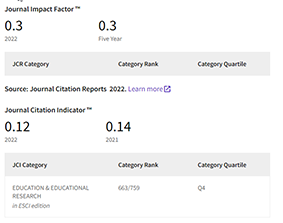Laboratory work as a teaching method: A historical case study of the institutionalization of laboratory science in Japan
DOI:
https://doi.org/10.14516/ete.177Palabras clave:
laboratory work, heuristic method, laboratory teaching method, Japan, the United Kingdom, the United StatesResumen
Practical work, including laboratory work, has been part of science education for more than a century, and is considered an essential component of science teaching. This paper uses historical insights to demonstrate that there is a pressing need to critically examine the role of laboratory work in science teaching. The author performed a historical case study of laboratory work in Japan from the 1880s to the 1930s. Given that the West, particularly the United Kingdom and United States, has influenced Japanese education since Japan began to modernize in the late 19th century, this study refers to the history of those nations with respect to laboratory work, and compares their educational system to that of Japan. The author concludes that practical work (including laboratory work) should be considered a means to an end - not an end in itself - with teachers sufficiently educated/trained in both science and pedagogy, functioning as facilitators who provide students with learning support. Without enthusiastic and knowledgeable teachers, the benefits of quality facilities and an established system cannot be fully realized. Thus, in conducting practical work, emphasis ought to be placed on its purpose and what students can learn from the experience - not on merely the actions they perform in conducting such work.
Referencias
Armstrong, H. E. (1903). The teaching of scientific method and other papers on education. London: MacMillan.
Board of Education (1911). Report of the Board of Education for the year 1909-1910. London: His Majesty’s Stationery Office.
Board of Education (1938). Report of the consultative committee on secondary education with special reference to grammar schools and technical high schools. London: His Majesty’s Stationery Office.
British Association for the Advancement of Science (1868). Report of the (Dundee) meeting, 1867. London: John Murray.
British Association for the Advancement of Science (1918). Report of the British Association for the Advancement of Science 1917. London: John Murray.
Brock, W. H. (1973). H. E. Armstrong and the teaching of science: 1880-1930. London: Cambridge University Press. doi: 10.2307/3119982.
Brock, W. H. (1998). The chemical origins of practical physics. Bulletin for the History of Chemistry, 21, 1-11.
Bruner, J. (1960). The process of education. New York: Vintage.
Cooke, J. P. (1891). Laboratory practice: A series of experiments on the fundamental principles of chemistry. New York: D. Appleton and Company.
Curtis, S. J. (1965). History of education in Great Britain (6th ed.). London: University Tutorial Press.
DeBoer, G. (1991). A history of ideas in science education: Implications for practice. New York: Teachers College Press.
Goto, M., & Miyake, Y. (1885). Experimental methods in physical sciences with simple apparatuses [in Japanese]. Tokyo: Fukyūsha.
Goto, M., Shinoda, T., Takizawa, K., & Yagyu, Y. (1885). Physics textbooks for elementary students, Vol. I to III [in Japanese]. Tokyo: Fukyūsha.
Gott, R., & Duggan, S. (1995). Investigative work in the science curriculum. Buckingham: Open University Press.
Guthrie, F. (1877). Outline of experiments and description of apparatus and materials. London: Eyre & Spottiswoode.
Hodson, D. (1991). Practical work in science: Time for a reappraisal. Studies in Science Education, 19, 175-184. doi: 10.1080/03057269108559998.
Hodson, D. (1993). Re-thinking old ways: Towards a more critical approach to practical work in school science. Studies in Science Education, 22, 85-142. doi: 10.1080/03057269308560022.
Hodson, D. (1998). Is this really what scientists do? Seeking a more authentic science in and beyond the school laboratory. In Wellington, J. (Ed.), Practical work in school science: Which way now? (pp. 93-108). London: Routledge. doi: 10.4324/9780203267059.
Hofstein, A., & Lunetta, V. N. (1982). The role of the laboratory in science teaching: Neglected aspects of research. Review of Educational Research, 52(2), 201-217.
Huxley, T. H. (1895). Science and education. London: Macmillan.
Isozaki, T. (2014). The organization and the recontextualization of Rika (school science) education in the second half of the nineteenth century in Japan. Science & Education, 23(5), 1153-1168. doi: 10.1007/s11191-013-9615-4.
Isozaki, T. (2015). Lesson study research and practice in science classrooms. In Gunstone, R. (Ed.), Encyclopedia of science education (pp. 615-618). Dordrecht: SpringerReference. doi: 10.1007/978-94-007-2150-0_412.
Isozaki, T. (2016). How have Japanese rika (school science) teachers traditionally formed their own cultures and improved their teaching competencies through research and practice? In Mei-H. Chiu (Ed.), Science education research and practice in Asia: Challenge and opportunities (pp. 517-537). Heidelberg: Springer. doi: 10.1007/978-981-10-0847-4_28.
Isozaki, T., & Isozaki, T. (2011). Why do teachers as a profession engage in lesson study as an essential part of their continuing professional development in Japan? International Journal of Curriculum Development and Practice, 13(1), 31-40.
Itakura, K., & Yagi, E. (1974). The Japanese research system and the establishment of the Institute of Physical and Chemical Research. In Nakayama, S., Swain, D. L., & Yagi, E. (Eds.), Science and society in modern Japan: Selected historical sources (pp. 158-201). Cambridge, Massachusetts: MIT Press.
Jenkins, E. W. (1979). From Armstrong to Nuffield: Studies in twentieth-century science education in England and Wales. London: John Murray.
Jenkins, E. W. (1989). Processes in science education: An historical perspective. In Wellington, J. (Ed.), Skills and processes in science education (pp. 21-46). London: Routledge.
Jenkins, E. W. (1998). The schooling of laboratory science. In Wellington, J. J. (Ed.), Practical work in school: Which way now? (pp. 35-51). London: Routledge.
Kametaka, T. (1904). On the chemistry teaching methods in Japanese secondary schools [in Japanese]. The Bulletin of the Tokyo Chemical Society, 25, 511-519.
Kanbe, I. (1922). New method of teaching science focused on children’s learning [in Japanese]. Tokyo: Meguroshoten.
Kanbe, I. (1938). Historical development of science education in Japan [in Japanese]. Tokyo: Keibunsha.
Kataoka, S., & Isozaki, T. (2003). Students’ practical work in chemistry classes in secondary schools for boys during the Taisho era: with a local historical approach [in Japanese with English abstract]. The Bulletin of Japanese Curriculum Research and Development, 26(3), 11-22.
Kerr, J. F. (1963). Practical work in school science: An account of an inquiry sponsored by the Gulbenkian Foundation into the nature and purpose of practical work in school science teaching in England and Wales. Leicester: Leicester University Press.
Kikuchi, D. (1909). Japanese education: Lectures delivered in the University of London. London: John Murray.
Kōno, M. (1953). History of practical work in science learning [in Japanese]. Science Education Monthly in Japan, 2(5), 44-46.
Layton, D. (1973). Science for the people: The origins of the school science curriculum in England. London: George Allen & Unwin.
Mann, C. R. (1910). The present condition of physics teaching in the United States. In Hodson, F. (Ed.), Broad lines in science teaching (pp. 227-238). New York: Macmillan.
Monbusho (Ministry of Education, Science and Culture) (1940). The history of regulations on secondary schools [in Japanese]. Tokyo: Monbusho.
Nakagawa, K. (1891). Simple apparatuses for chemistry [in Japanese]. Tokyo: Kinkōdō.
Nakagawa, H. (1979). On the historical development of laboratory work by students in physics and chemistry [in Japanese]. Science through experiments, 30(7), 598-603.
National Education Association (1894). Report of the committee of ten on secondary school studies. New York: American Book Company.
Nature (1875), 12(298), 203-206.
Nature (1879), 19(484), 311-312.
Ogawa, M. (2015). Rika. In Gunstone, R. (Ed.). Encyclopedia of science education (p. 840). Dordrecht: SpringerReference. doi: 10.1007/978-94-007-2150-0_419.
Osborne, J. (1998). Science education without a laboratory? In Wellington, J. (Ed.), Practical work in school science: Which way now? (pp. 156-173). London: Routledge.
Oshima, C. (1917). Modern school education and science teaching in the West [in Japanese]. Tokyo: Tokyo-Hōbunkan.
Oshima, C. (1918). Some problems of physical sciences’ facilities in boys’ secondary schools [in Japanese]. School Education, 5(55), 1-14.
Oshima, C. (1920). The principles of science teaching [in Japanese]. Tokyo: Dōbunkan.
Oshima, C. (1935). New introduction of science education [in Japanese]. Tokyo: Monasu.
Oshima, C. (1937). The present and future of science education in Japan. In Huzimoto, H., Ishikawa, S., Okada, Y., Oshima, S. Shinotō, Y., & Takeuchi, T. (Eds.), Science education in Japan (pp. 1-8). Tokyo: Kokusai Shuppan Insatsusha.
Richmond, P. E., & Quraishi, A. R. (1964). Armstrong’s heuristic method in 1964. School Science Review, 157, 511-519.
Roscoe, E. (1872). Science Primers: Chemistry. London: MacMillan.
Rosen, S. (1954). A history of the physics laboratory in the American public high school (to 1910). American Journal of Physics, 22(4), 194-204. doi: 10.1119/1.1933679.
Rudolph, J. L. (2005). Epistemology for the masses: The origins of «the scientific method» in American schools. History of Education Quarterly, 45(3), 341-376. doi: 10.1111/j.748-5959.2005.tb00039.x.
Sakai, Y., & Isozaki, T. (2005). A historical study of practical work for students in physics and chemistry classes in old secondary schools for boys and normal schools (1918-1942): A local history in Shizuoka prefecture [in Japanese with English summary]. Journal of Research in Science Education in Japan, 52(2), 43-52.
School Science Review (1929), 11(41), 65-70.
Schwab, J. J. (1962). The teaching of science as enquiry. In Schwab J. J., & Brandwein, P. F. (Eds.), The teaching science (pp. 1-103). Cambridge, MA: Harvard University Press.
Science Study Group of the Hiroshima Higher Normal School (1932). Students’ notebook for chemistry laboratory work [in Japanese]. Osaka: Sekizenkan.
Smith, A., & Hall, E. (1910). The teaching of chemistry and physics in the secondary school (revising and reprinted ed.). New York: Longman, Green and Co.
Stewart, B. (1872). Science primers: Physics. London: MacMillan.
Tanahashi, G. (1913). The new method of teaching natural science in primary and secondary schools [in Japanese]. Tokyo: Tokyo Hōbunkan.
Tanahashi, G. (1918). Revised the new method of teaching natural science in primary and secondary schools [in Japanese]. Tokyo: Tokyo Hōbunkan.
Tanahashi, G. (1941). Retrospect of natural science education in Japan [in Japanese]. The Monthly Journal of Monbsho, 730, 53-62.
Tanahashi, G., & Mori, K. (1914). Guidance in physics laboratory work [in Japanese]. Tokyo: Ōkurashoten.
Tanahashi, G., & Mori, K. (1916). Guidance in chemistry laboratory work [in Japanese]. Tokyo: Ōkurashoten.
Terakawa, T., & Brock, W. H. (1978). The introduction of heurism into Japan. History of Education, 7(1), 35-44. doi: 10.1080/0046760780070104.
The Bulletin of the Tokyo Academy of Physics [in Japanese] (1918), 311, 420-423.
The Monthly Journal of Monbusho [in Japanese] (1876), 4, 197-198, 301-302.
Thomson Committee (1918). Report of the committee appointed by the prime minister to enquire into the position on natural science in the educational system of Great Britain. London: Her Majesty’s Stationery Office.
Turner, D. M. (1927). History of science teaching in England. London: Chapman & Hall.
Uzzell, P. (1978). The changing aims of science teaching, School Science Review, 60(210), 7-20.
Westaway, F. W. (1929). Science teaching: What it was - what it is - what it might be. London: Blackie & Son.
Woolnough, B., & Allsop, T. (1985). Practical work in science. London: Cambridge University Press.
Yoshioka, K. (M. Goto, revised) (1895). Simple experiments in physics [in Japanese]. Tokyo: Fukyūsha.







